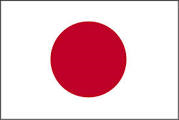This week we are studying one of my favorite gastronomic destinations of all, Japan. Japan is referred to by the Japanese as Nippon which literally means "The Sun's Origin". To me, thoughts of Japan evokes images of Mystical Beauty, Tradition, Honor, Paradoxes, and Progressiveness. This enchanting island nation, known as the land of the rising sun, has held onto so many long standing traditions while pushing the envelope in very progressive and modern popular cultural as well. No other country in the world seems to have experienced such a confluence of tradition, technology, and circumstance.

Japanese culture is rich and diverse, dating back to 10,000BC when the Jomon people first settled in Japan. It is widely known for its traditional arts as well as its contemporary culture. A sophisticated cuisine, unique social customs, and refined performing and visual arts also contribute to a culture which has drawn in many visitors.
I remember at age 15, reading one of my favorite books of all time, Memoirs of a Geisha, and thinking what an unique and mysterious land Japan really is. Japan's culture is full of paradoxes and is unlike any other, especially between old and new, traditional and modern. Today in Japan you can still walk the streets of Kyoto and observe Geishas in traditional kimonos just as they were 100 years ago, shuffling down the street with umbrellas overhead.
Sumo wrestling, a centuries old tradition is still taken extremely seriously in Japan. Sumo originated in Japan many centuries ago, and today it is the only country where it is practiced professionally. It is generally considered to be a modern Japanese martial art. Many ancient traditions have been preserved in sumo, and even today the sport includes many ritual elements, such as the use of salt purification, from the days when sumo was used in the Shinto religion. Life as a wrestler is highly regimented, with rules laid down by the Sumo Association. Most sumo wrestlers are required to live in communal "sumo training stables" known in Japanese as heya where all aspects of their daily lives—from meals to their manner of dress—are dictated by strict tradition.
Tea ceremony still plays a vital role in modern Japan. The first documented evidence of tea in Japan dates to the 9th century, when it was taken by the Buddhist monk Eichū on his return from China.It is still very common to see tea houses all over the island no matter how remote the town and tea ceremony is practiced in many Japanese families today with high reverence.
However, at the same time, you can go to the Harajuku neighborhood of Tokyo and see the super modern Harajuku style girls, Japan's most extreme teenage cultures and fashion styles. Many young people gather around Harajuku Station and engage in costume play, dressed up in eccentric costumes to resemble anime characters and punk musicians. It seems that modern Japanese entertainment which is heavily technology driven is an escape for the contemporary Japanese from the problems of an industrial world. When asked how they spent their leisure time, 80 percent of a sample of men and women surveyed by the government in 1986 said they averaged about two and a half hours per weekday watching
television, listening to the radio, and reading newspapers or magazines.
Many anime and manga are very popular around the world and continue to become popular, as well as Japanese video games, music, fashion, and game shows;this has made Japan an "entertainment superpower" along with the United States and the United Kingdom.
In the late 1980s, the family was the focus of leisure activities, such as excursions to parks or shopping districts. Although Japan is often thought of as a hard-working society with little time for leisure, the Japanese seek entertainment wherever they can. It is common to see Japanese commuters riding the train to work, enjoying their favorite manga, or listening through earphones to the latest in popular music on portable music players. Game centers, bowling alleys, and karaoke are popular hangout places for teens while older people may play shoji or go in specialized parlors.
Natural hot springs known as onsen, are numerous and highly popular across Japan. The Japanese believe the hot springs provide healing through their rich mineral content. Traditionally, the Japanese place great importance on the concept of wa, or group harmony. The value of the common greater good is more important than valuing one's own needs. This principle is applied in schools, as well as social groups and, later in life, the workplace.

The cuisine of Japan has long been my personal favorite. It is all about quality of ingredients, texture, and extreme attention to detail. This week we will cook traditional dishes eaten frequently in Japanese homes. We will start with a very classic favorite especially among Japanese businessmen, Beef Yakitori. This dish is made from sirloin beef marinated in ginger, scallion, soy, garlic, and sesame seeds, then grilled on skewers. Sounds delicious!
We will also cook Ebi Chili, shrimp cooked in a spicy sweet sauce with Sriracha chili, Thai Sweet Chile sauce, ginger, and scallions.
This dish was created by famous Chen Kenmim who emigrated to Japan in the 1950's from Szechuan province in China. Chef Chen Kenmim went on to become a TV celebrity all over Japan popularizing his Chinese influenced cuisine. He is widely regarded as the Father of Japanese style Szechuan cuisine. We will prepare sticky rice which is a common accompaniment to most Japanese Meals, and lastly for our vegetable Komatsuna
no ohitashi -Stir Fried Mustard Spinach with Sake, Garlic, Sesame Oil, Chile and Pepper.
http://iml.jou.ufl.edu/projects/Spring01/Newsome/culture.html
















I am so glad you chose Japan. What a wealth of culture and cuisine.
ReplyDelete